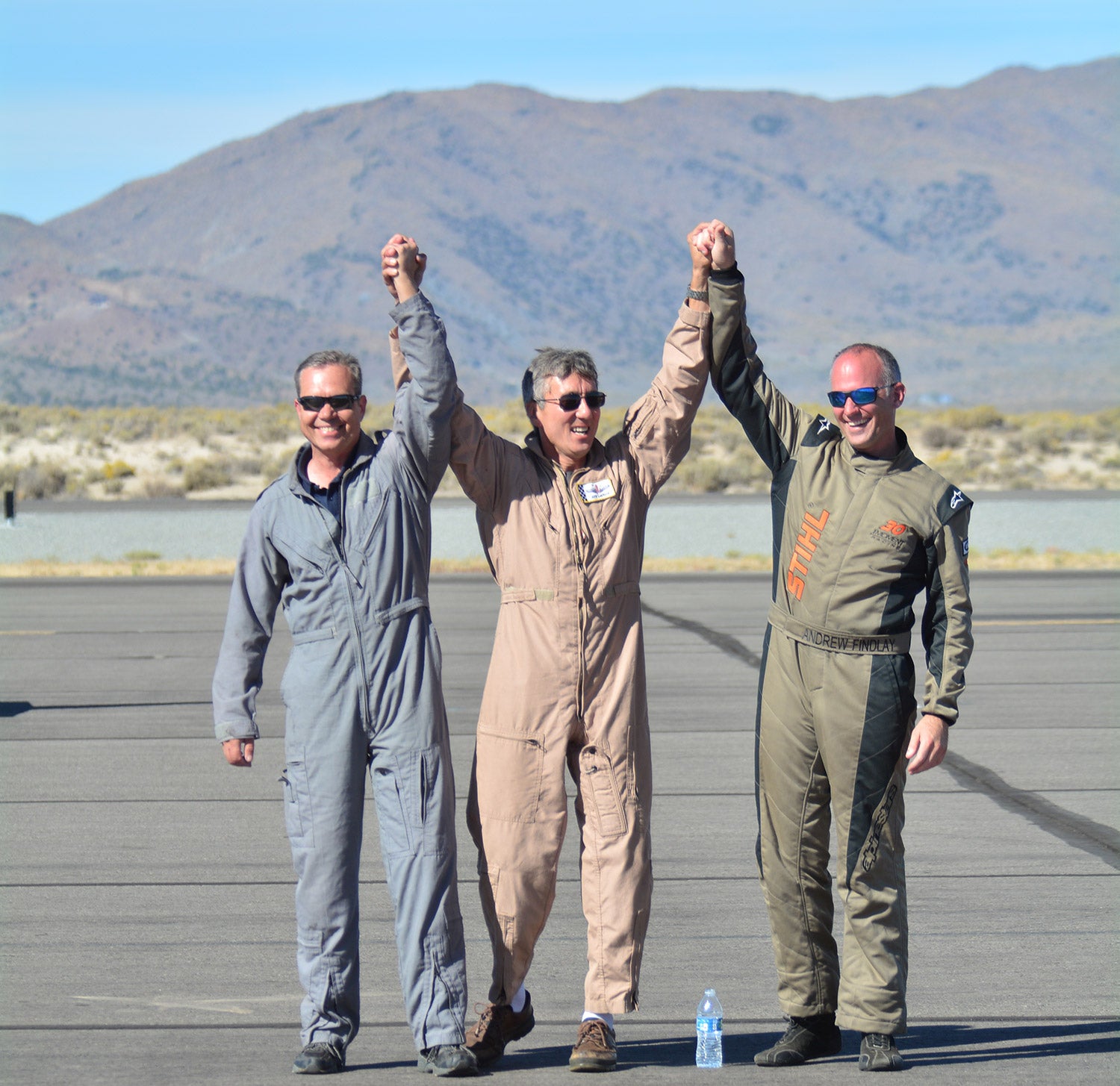
After a flag pole bending, wind-blown Saturday afternoon with resulting race postponements, Sunday has been bright, blue, very cool and harboring an energetic if not overly threatening 17 knot breeze today. It’s also the final day, the time to turn the screws all the way down and run for the money.
Getting the day to an excellent start was the Formula 1 class. We were sure Justin Meaders was in it to win it, and we weren’t disappointed. While it’s always a pleasure to watch Meaders give one of his seminars on how to run level, consistent, fast lines, our attention turned to the second place battle between Justin Phillipson and Jim Jordan as Meaders ran away.
Jordan had the faster plane in Miss Min, but Phillipson has the faster starts and a canny ability to make his Shoestring a mile wide. Poor Jordan ran high, low, alongside, dove for speed on the back straight and generally did all he could but his speed advantage just wasn’t enough for Phillipson’s savvy around the pylons. So, while Meaders posted a 237 mph average race speed, Phillipson and Jordan were right on top of each other at the finish, both with 225 mph speeds.
All pilots reported the race as the bumpiest session ever on the Reno course. Turbulence from the morning winds had everyone hammering their heads against the canopy and mainly happy to be on the ground in one piece. Comfortable it wasn’t.
The Biplane class looked at conditions and voted to stand down, awarding the race based on previous heat racing. Thus, Jake Stewart in Bad MoJo took biggest tin cup, followed by Scott Thomson in Second Hand and Tommy Suell in Shake-N-Bake. All were mounted in highly modified Pitts S-1’s.
In some sort of dubious distinction, the Biplane class hasn’t had a real, flying Gold race since 2018. Next year.
Then there was the headliner, the Sport Gold final. Who brought how much was instantly revealed when Jeff LaVelle (Glasair III) hammered his Ly-Con built 580 Lycoming while everyone else was getting there as fast as they could. In truth, the race was LaVelle, Andrew Findlay (Lancair Super Legacy) and Jim Rust (Glasair III) running in a fast, close train, with Kevin Eldredge finally up to speed after a week of technical challenges, but not quite the same speed as the top three. Far behind Eldredge, the first of the having fun racers, Mathias Haid, was giving his naturally-aspirated Thunder Mustang a good gallop.
And as has become the norm as the big Sport racers hone their craft, the pace never relented. LaVelle simply kept at it, with Findlay perhaps just not quite keeping up to LaVelle but also putting the slightest gain on Rust. Eldredge was well astern, an honest half a lap behind LaVelle by lap four. It was a spectacular display of speed, with all the delicious humming prop noise as the train approached followed by the muffled uumph of tortured air and turbo exhaust as each racer passed in turn. And yes, everyone in the house was on the action.

That’s the way they finished, but then the preliminary results showed Findlay fined 12 seconds for close racing during the critical first turn maneuvering at the start. The racers themselves were happy about the action post race and it’s possible some change win the standings may take place before the results are final.
The race was just what the sport needed. It was enjoyably fast, LaVelle laying down a 400.834 mph race average—fastest Sport speed of the week by far—with Findlay somewhere well into the 390 mph bracket and Rust posting 389 mph.
Generally, it’s been a great Reno race weekend. It was simply great to see racing again after a year’s layoff. The wildfire smoke was around at times, but never cancelled an event. The fields were full enough and the Sport Gold racers truly set the pace this year. The arrival of Jim Rust to the top level, the return to speed of Jeff LaVelle, finally seeing Kevin Eldredge turn some fast laps and the hint of what could be in Karl Grove’s new engine are all exciting developments. Can Findlay match LaVelle’s speed? We wouldn’t worry about that, but clearly running at the front of a more populous Sport Gold race is not getting any easier.
Looking forward to next year, for sure.













I checked the specs on a Glassair III. Cruise speed 230 knots. How did Mr. LaVelle get an average speed of 400 knots out of his Glassair III? Listed stock engine is a Lycoming IO-540. Super charged or turbo charged IO-540 or a larger engine? Does not appear to have room for a larger engine in a Glassair III. Aircraft I believe are always turbo charged. Only the 2D characters use super charging, I believe. When did the military propeller aircraft disappear?
The way to get 400 mph out of a Glasair III is to put twin turbochargers on it and run the manifold pressure to the moon. That, along with a bit of wing clipping and aerodynamic clean up is the short version, but Gold Sport racers are edging into the 90 In. Hg. of manifold pressure window which yields around 900 hp in the more advanced machinery. Both Continental 550 and Lycoming 540/580 engines are popular in Sport Gold.
As for the “military propeller aircraft” such as the Sea Fury and P-51, they are still present in somewhat limited numbers in the Unlimited class. We do not cover them much in Kitplanes as their technology does not overly relate to what our readers are doing, but we do take the occasional peek at the Unlimiteds as they are informative of the outer limits of piston engine and high-speed propeller flight technology.